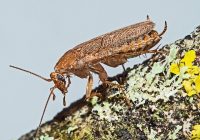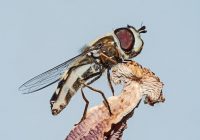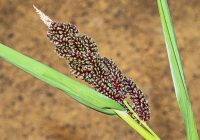Dr Phil Smith’s Wildlife Notes
August 2022
For most of the year, my notes have reported drought conditions on the Seton Coast. These intensified in August, only three days registering measurable rainfall. Thunderstorms that provided welcome relief further south missed us (as usual!). There was also a heatwave from 11th to 14th with temperatures up to about 300C. As a result the sand-dune water-table fell about 10 cm to its lowest level since late summer 2018, also a drought year. The Met. Office confirmed that the three summer months were the joint warmest on record for the UK and the driest since 1976.
The effects of the drought on our wildlife were evident, many insect groups being badly impacted. Apart from Gatekeepers, butterflies were thin on the ground, though there was a decent hatch of second generation Common Blues. A few Painted Ladies, derived from earlier immigrants, began to appear in mid-month, being especially attracted to flowering Common Fleabane. As in July, except for the big Plumehorns, hoverflies were in short supply. Similarly, there were many fewer dragonflies than usual; hardly surprising when so many dune pools were dry. One major exception, however, was on Hesketh Golf Course, where Jack Taylor obtained permission for a small group of us to survey a pond where Small Red-eyed Damselfly had been reported. This newcomer to Merseyside has been spreading north since its first appearance in Essex in 1999. We were delighted to count 15 Small Red-eyes, including several mating pairs, on two ponds. Also present were Brown and Migrant Hawker, Emperor, Common Darter, Blue-tailed and Emerald Damselflies. These observations were notified to the club.
There were several other insect highlights during the month, perhaps the best being a Tawny Cockroach at Hightown dunes. This small native cockroach mostly lives in southern England but, in 2020, Tony Hunter from Liverpool Museum unexpectedly found it at Hightown. I knew the exact spot, so I took my sweep-net and, within a couple of minutes, rejoiced to find one in the net. Obviously, there must be a small breeding colony, though how it got to Hightown is a mystery. I also took my net to Falklands Way, Ainsdale, hoping to catch a Speckled Bush-cricket where a small colony has persisted for several years. No luck with the bush-cricket but I did catch several different shieldbugs and a lovely Grey Dagger moth caterpillar. Another unexpected find was a Heath Assassin Bug in the Devil’s Hole. This bug is so well camouflaged that it is almost impossible to see amongst vegetation; however, this individual had strayed onto bare sand where it was more easily spotted. Its portrait will appear, with many others, in my forthcoming book on the Insects of the Sefton Coast.
The dried-up ponds on Freshfield Dune Heath Nature Reserve were surrounded by Water Mint, a great attraction to nectaring insects. These included two giant Hornet Plumehorns but even better was a mating pair of Waisted Beegrabbers, a southern insect that doesn’t get much further north than the Sefton Coast. I have rarely photographed it before. I also came across an Orange-legged Furrow-bee nectaring on Common Fleabane at Birkdale Green Beach. This solitary bee is supposed to be common and widespread but it was new to me. Another potential newcomer is a bee that Tim Rogers reported two years ago nesting on the tidal Shrimper’s Track at Marshside. This could be Sea Aster Colletes, a bee that is supposed to be confined to the south and southeast of England where it relies on saltmarsh Sea Aster for pollen and nectar. Trevor Davenport and I went up to Marshside on 28th and, after an hour of searching, we found lots of typical Colletes nest holes with little piles of excavated sand along the edge of the track. Colletesfemales soon started to arrive with pollen loads. As microscopic examination is required to identify the species, we collected two specimens to send to the bee expert Ben Hargreaves. Also pleasing to see were Short-winged Coneheads in the saltmarsh vegetation and a lovely migrant hoverfly, the White-clubbed Glasswing.
Plant highlights during the month included a new young bush of the extremely rare Don’s Willow at the Devil’s Hole, where there was a decent flowering of Grass-of-Parnassus. However, this beautiful flower was much more abundant on the southern section of Birkdale Green Beach, north of Ainsdale-on-Sea. Here, white drifts of thousands of plants resembled an unseasonal snowfall; an incredible sight. Nearer to home, a large grass was emerging from a paving crack outside my lounge window. Rather than pull it up as a ‘weed’ as many would have done, I waited for it to flower. This was worthwhile, as it turned out to be Sorghum or Great Millet, native to Africa and an important food crop worldwide. My plant was no doubt derived from bird-seed. Interestingly, records of Sorghum are few and far between in the UK, with only one for ‘Lancashire’, at Bolton in 1999.
For some years, I have intended to survey the Variegated Horsetail, a relatively insignificant plant of dune-slacks and scrapes. Recently, an eminent botanist described it as “Vanishingly rare in lowland England” but we have lots of it. My database lists dozens of duneland sites where it’s been seen over the last 20 years or so. I decided to visit the more accessible of these to see whether it was still there, describe its ecology and record any threats. Preliminary results show that this special little horsetail still survives at most of its known sites, though often in reduced quantity. It has disappeared from several places, due to invasion by coarse vegetation and scrub, a commonplace problem in the dunes. At the end of the recording season, I intend to publish the findings in a scientific journal. As well as enjoying the natural wonders of the Sefton Coast, it is important to put them on record.






